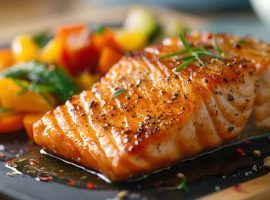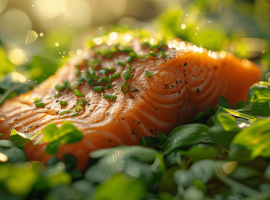Fish Recipes for Dogs: Unveiling the Health Benefits
When considering the inclusion of fish in your dog’s diet, it’s essential to understand the myriad of health benefits it offers. Fish is a powerhouse of nutrition, rich in omega-3 fatty acids, which are pivotal for your dog’s well-being.
Omega-3 Fatty Acids: A Boost for Canine Health
Omega-3 fatty acids, found abundantly in fish, are known for their anti-inflammatory properties. They play a crucial role in maintaining your dog’s cardiovascular health, ensuring a strong and healthy heart. But the benefits don’t stop there.
Cognitive Advantages of a Fish-Enriched Diet
A diet rich in fish can also contribute to your dog’s cognitive health. These fatty acids are vital for brain development and function, particularly beneficial for puppies and senior dogs. By incorporating fish into your dog’s meals, you’re supporting their mental agility and cognitive longevity.
Dermatological Health: The External Indicator of Internal Wellness
The condition of your dog’s skin and coat is a direct reflection of their internal health. Fish, with its high omega-3 content, can lead to a lustrous coat and healthy skin. This not only means your dog will look better, but they’ll also be less prone to skin conditions that can cause discomfort and irritation.
At Frozen Fish Direct, we understand the importance of providing your dog with the best nutrition possible. That’s why we offer a variety of high-quality, fresh fish options that can help enhance your dog’s diet and overall health. With our guidance, you can confidently prepare meals that will not only satisfy your furry friend’s palate but also contribute to their long-term health and happiness.
Selecting the Right Fish: A Guide for Dog Owners

When it comes to enhancing your dog’s diet with fish, choosing the right type is paramount for their health and safety. At Frozen Fish Direct, we understand the importance of providing your beloved pet with the best nutrition possible.
Recommended Fish Varieties for Canine Diets
We recommend incorporating fish that are low in mercury and high in omega-3 fatty acids. Some of the safest options for your dog include:
These fish are not only nutritious but also generally lower in mercury, making them a great choice for your dog’s homemade meals.
Identifying High-Mercury Fish to Avoid
It’s crucial to avoid fish known for high mercury levels, as mercury can be toxic to dogs. Be wary of:
- King Mackerel
- Swordfish
- Shark
- Tilefish
Safe Fish Options for Homemade Meals
When preparing homemade meals, ensure you’re using fish that’s fresh and properly handled. Our selection at Frozen Fish Direct is sourced responsibly to guarantee quality and safety.
Including Canned Tuna in Your Dog’s Diet
Canned tuna can be included in moderation due to its higher mercury content. Opt for canned tuna in water rather than oil and avoid any with added salt or spices. Remember, when it comes to feeding your dog fish, moderation and variety are key to a balanced diet.
Mastering Homemade Fish Cuisine for Canine Health

Creating a balanced and nutritious fish meal for your dog at home can be a rewarding experience. At Frozen Fish Direct, we’re committed to helping you ensure that every meal you prepare contributes to your dog’s health and happiness.
Ensuring Nutritional Adequacy in Homemade Fish Meals
To guarantee that the fish meals you prepare at home are nutritionally complete, it’s essential to:
- Include a variety of fish rich in omega-3 fatty acids, such as salmon and mackerel.
- Balance the fish with healthy carbohydrates like brown rice or quinoa.
- Add vegetables such as peas or carrots for fibre and vitamins.
- Consult with your veterinarian to ensure the meals meet your dog’s specific dietary requirements.
Vet-Approved Recipes for Your Canine
We recommend vet-approved recipes that cater to the nutritional needs of dogs. These recipes should include:
- A good source of lean protein from fish.
- Carbohydrates for energy, from sources like sweet potatoes.
- A mix of vegetables for essential nutrients.
- Supplements as advised by your vet, such as vitamins or minerals.
Catering to Canine Allergies with Fish Recipes
If your dog has allergies, you can still prepare fish-based meals by:
- Choosing fish that are less likely to cause allergic reactions, such as tilapia or trout.
- Avoiding common allergens like wheat by using alternative flours, such as coconut flour.
- Keeping a close eye on your dog’s reaction to new ingredients.
Key Ingredients for a Balanced Fish Meal
A well-rounded homemade fish meal for dogs should include:
- Protein: Cooked, deboned fish.
- Carbohydrates: Rice, oatmeal, or lentils.
- Vegetables: Spinach, pumpkin, or broccoli.
- Healthy fats: A drizzle of olive oil or flaxseed oil.
By following these guidelines, you can create delicious and healthy meals that will keep your dog’s tail wagging.
Cooking Fish for Dogs: Best practices
Preparing fish for your dog’s diet requires careful attention to both the cooking process and bone removal to ensure their safety and health. At Frozen Fish Direct, we advocate for practices that preserve the nutritional integrity of fish while making it safe for canine consumption.
The Importance of Cooking Fish for Canine Safety
Cooking fish is essential for eliminating harmful bacteria and parasites that could be present in raw fish. It’s crucial for your dog’s health to:
- Thoroughly cook the fish to the appropriate temperature.
- Avoid feeding raw fish, which can lead to foodborne illnesses.
Safe Cooking Methods for Dogs
To retain the nutritional benefits of fish while ensuring it’s safe for your dog, we recommend:
- Poaching: Gently cooks the fish and keeps it moist.
- Grilling: Provides a lean method without the need for oils.
- Baking: An easy and safe way to cook fish thoroughly.
- Steaming: Preserves nutrients and is easy on your dog’s digestion.
Meticulous Deboning for Your Dog’s Protection
Deboning fish is a critical step to prevent choking or internal injury. Ensure you:
- Remove all bones carefully after cooking.
- Inspect the fish thoroughly for any small or fine bones.
Seasoning-Free Meals for Canine Health
Seasonings and spices that are safe for humans can be harmful to dogs. When preparing fish for your dog:
- Do not add any seasonings, including salt, garlic, or onions.
- Keep it simple to avoid any adverse reactions.
By following these guidelines, you can confidently provide your dog with fish meals that are both nutritious and safe.
Creative Fish-Based Dog Food Recipes
Embarking on the journey of homemade dog food preparation can be a delightful way to cater to your pet’s health and taste preferences. At Frozen Fish Direct, we take pride in offering you a variety of fish that can be transformed into nutritious and delicious meals for your furry friend.
Preparing Fish Fillets and Veggies
For a balanced meal that’s rich in protein and vitamins, try the Fish Fillets and Veggies recipe:
- Select a low-mercury fish like tilapia or swai from our range.
- Steam or bake the fish until it flakes easily.
- Combine with cooked vegetables such as carrots and green beans.
- Mix in a carbohydrate like brown rice or quinoa for energy.
Nutritious Salmon and Quinoa Dog Meal
Salmon is an excellent source of omega-3 fatty acids, and when paired with quinoa, it makes for a heart-healthy meal for your dog:
- Cook the quinoa as per the instructions.
- Grill or bake the salmon from our selection, ensuring all bones are removed.
- Blend with steamed broccoli for added nutrients.
- Cool before serving to your canine companion.
Homemade Fish Cakes for Dogs
Fish cakes can be a tasty treat for your dog, and they’re simple to make:
- Mash boiled potatoes as the base.
- Mix in canned tuna from our product line, ensuring it’s in water and not oil.
- Add chopped parsley for flavour and peas for texture.
- Form into cakes and bake until firm.
Fish and Sweet Potato Mash Recipe
Sweet potatoes are a great source of dietary fibre and pair well with fish for a wholesome meal:
- Roast or boil sweet potatoes until tender.
- Combine with cooked, deboned fish like trout or mackerel.
- Mash together and add a drizzle of olive oil for healthy fats.
- Cool and serve as a delicious dinner for your dog.
By incorporating these recipes into your dog’s diet, you’re not only providing them with a variety of flavours but also ensuring they receive the necessary nutrients for a healthy life.
Incorporating Variety: Additional Ingredients for Dog Meals
A well-rounded diet is as important for our canine companions as it is for us. At Frozen Fish Direct, we encourage you to diversify your dog’s fish meals with a range of nutritious ingredients that cater to their health and palate.
Nutritious Vegetables to Pair with Fish
Adding vegetables to your dog’s fish meal not only enhances the flavour but also boosts the meal’s nutritional value. Consider these options:
- Spinach: Rich in vitamins A, B, C, and K, it supports bone health.
- Peas: Offer protein and fibre, promoting digestive health.
- Pumpkin Puree: A great source of fibre and vitamin A, it aids in digestive regularity.
Grains for Energy and Digestive Health
Grains can be a healthy part of your dog’s diet, offering energy and aiding digestion:
- Rice: Easily digestible and good for an upset stomach.
- Quinoa: A protein-packed grain that’s also rich in essential amino acids.
- Oatmeal: High in soluble fibre, which can help regulate blood glucose levels.
The Benefits of Including Sardines
Sardines are a small fish with big benefits:
- They’re low in mercury and high in omega-3 fatty acids.
- Small bones in sardines are soft and safe for dogs, providing calcium for bone health.
Tuna: To Drain or Not to Drain?
When using canned tuna:
- Keep the natural oils if it’s canned in water, as they contain beneficial nutrients.
- Avoid draining to retain omega-3 fatty acids that support your dog’s coat and skin health.
By incorporating these ingredients into your dog’s fish-based meals, you’re ensuring they receive a spectrum of nutrients essential for their well-being.
Homemade Fish Treats: Healthy Snacks for Training and Rewards
Creating homemade treats for your dog is a wonderful way to provide them with healthy snacks that are free from preservatives and tailored to their size and dietary needs. At Frozen Fish Direct, we believe in the joy of rewarding your furry friends with treats that are not only safe but also beneficial for their health.
Crafting Preservative-Free Fishy Dog Treats
To make preservative-free Fishy Dog Treats, you’ll need:
- Fresh fish: Choose a low-mercury option like salmon or tilapia from our selection.
- Binding ingredients: Use eggs to bind the mixture and create a dough-like consistency.
- Flour alternative: For dogs with sensitivities, opt for coconut flour as a healthy substitute.
Baking Instructions for Homemade Fish Treats
For baking your homemade fish treats:
- Preheat your oven to 350F (175C).
- Combine the ingredients and form them into shapes suitable for your dog’s size.
- Place on a baking sheet and bake for about 40 minutes or until golden and firm.
Sizing Treats for Your Dog
When creating treats:
- Consider your dog’s size: Smaller dogs require smaller treats, while larger dogs can handle bigger pieces.
- customise the size: Use cookie cutters or simply break the treats into appropriate sizes after baking.
Storing Your Homemade Dog Treats
To ensure freshness and longevity:
- Refrigerate: Store treats in a sealed container in the refrigerator for up to a week.
- Freeze: For longer storage, freeze the treats and thaw them as needed.
By following these steps, you can provide your dog with delicious, homemade fish treats that are perfect for training or as a reward.
Storing Homemade Dog Food: Tips for Freshness and Safety
Proper storage of homemade dog food is crucial to maintain its freshness and nutritional value. At Frozen Fish Direct, we understand that when you take the time to prepare meals for your furry family member, you want to ensure they remain safe and beneficial for as long as possible.
Refrigerating Your Dog’s Fish Meals
To keep your homemade fish dog food fresh in the refrigerator:
- Store in airtight containers to prevent contamination and odour transfer.
- Label containers with the date of preparation.
- Use refrigerated meals within 3 days to ensure freshness.
Freezing Homemade Dog Meals and Treats
For longer-term storage, freezing is an effective method:
- Portion the meals before freezing to make thawing easier.
- Wrap the food in freezer-safe bags or containers.
- Thaw in the refrigerator overnight before serving.
Special Considerations for Fish-Based Dog Food
When storing fish-based meals:
- Cool the food before refrigerating or freezing to prevent bacterial growth.
- Avoid refreezing previously thawed meals to maintain quality.
Maintaining Nutrient Quality During Storage
To ensure the meals retain their nutritional value:
- minimise exposure to air by using vacuum-sealed bags if possible.
- Keep the freezer temperature consistent to prevent nutrient degradation.
By adhering to these storage guidelines, you can be confident that the wholesome fish meals you prepare for your dog will remain safe and nutritious until they’re ready to be enjoyed.
Introducing Fish to Your Dog’s Diet: A Step-by-Step Guide
Integrating fish into your dog’s diet can be a fantastic way to boost their intake of omega-3 fatty acids and improve overall health. At Frozen Fish Direct, we’re here to guide you through this transition smoothly and safely.
Gradual Introduction of Fish
To start incorporating fish into your dog’s meals:
- Begin with small amounts: Add a little cooked fish to their regular food.
- Monitor their reaction: Look for signs of enjoyment or any adverse reactions.
- Increase gradually: If they respond well, slowly increase the fish portion over time.
Determining Appropriate Portion Sizes
Portion sizes should be tailored to your dog’s size and caloric needs:
- Small breeds: A teaspoon of cooked fish as a starter.
- Medium breeds: Start with a tablespoon of fish.
- Large breeds: A couple of tablespoons can be the initial portion.
The Role of Veterinary Guidance
Consulting with a vet is crucial to ensure the dietary change is suitable for your dog’s specific health needs:
- Get professional advice: A vet can provide personalised portion size recommendations.
- Consider health conditions: Some conditions may require special dietary considerations.
Monitoring Your Dog’s Health
As you introduce fish, keep an eye on:
- Digestive health: Watch for any changes in their stool or signs of discomfort.
- Energy levels: Note any increases or decreases in activity.
- Coat and skin condition: Look for improvements in shine and softness.
By following these steps, you can ensure a successful and healthful addition of fish to your dog’s diet.
Ensuring Your Dog’s Health: Monitoring and Adjustments
As you introduce fish into your dog’s diet, it’s essential to monitor their health and make any necessary adjustments. At Frozen Fish Direct, we prioritise your dog’s well-being and offer guidance on what signs to look for to ensure they are thriving on their new diet.
Assessing Your Dog’s Fur Condition
A healthy diet often reflects in your dog’s coat. After adding fish to their meals, observe for:
- Increased shine: Look for a glossy sheen on their fur.
- Reduced flakiness: A decrease in dry skin and dandruff.
- Softness: The fur should feel soft to the touch.
Tracking Digestive Health
Maintaining digestive health is crucial. Post dietary changes, monitor for:
- Consistent stool: Regular, firm bowel movements indicate good digestive health.
- Appetite: Ensure your dog maintains a healthy appetite.
- No discomfort: Watch for signs of gas, bloating, or discomfort.
Signs of Allergies to Be Vigilant About
Allergies can manifest in various ways. Be alert for:
- Itching or scratching: Excessive grooming or scratching can indicate an allergy.
- Gastrointestinal upset: Vomiting or diarrhoea may occur if your dog is allergic.
- Ear infections: Frequent infections can be a sign of food sensitivities.
Fish’s Contribution to Joint Wellness
Omega-3 fatty acids in fish can support joint health. You may notice:
- Improved mobility: Easier movement and less stiffness.
- Reduced inflammation: Omega-3s have anti-inflammatory properties.
By keeping a close eye on these health indicators, you can ensure that fish is a beneficial addition to your dog’s diet.
Community Engagement: Sharing and Learning Together
At Frozen Fish Direct, we believe that sharing knowledge and experiences is key to enriching the lives of our canine friends. That’s why we encourage you to join our community of dog lovers who are passionate about creating healthy, homemade fish recipes for their pets.
Participate in Recipe Exchanges
Joining our community allows you to:
- Share your favourite fish recipes and discover new ones from fellow dog owners.
- Learn from others’ experiences to perfect your homemade dog food preparation.
Support for Ingredient Substitutions and Allergy Concerns
We understand that every dog is unique, and some may have specific dietary needs. Our community is here to help you with:
- Finding alternative ingredients that cater to your dog’s allergies or sensitivities.
- Providing suggestions for substitutions that maintain the nutritional value of the meals.
Engaging with Others on Storage and Serving Size Questions
Frozen Fish Direct offers support on practical aspects of homemade dog food, such as:
- Best practices for storing your homemade fish dog food and treats.
- Advice on portioning meals correctly according to your dog’s size and dietary needs.
The Role of the Comment Section
Our comment section is a vibrant space for:
- Asking questions and receiving timely advice from our community members.
- Engaging in discussions that enhance our collective knowledge on canine nutrition.
By participating in our community, you’re not just feeding your dog betteryou’re becoming part of a movement towards healthier, happier pets.
Contact Us: Your Guide to Canine Fish Cuisine
At Frozen Fish Direct, we’re dedicated to assisting you in selecting the perfect fish for your dog’s diet. We understand that navigating the best choices for canine nutrition can be complex, and we’re here to provide clarity and support.
Choosing the Right Fish with Our Help
When you’re looking to incorporate fish into your dog’s meals, our team is ready to:
- Offer recommendations on the best fish varieties for your dog’s specific dietary needs.
- Provide insights on how to balance your dog’s diet with our selection of fish.
The Benefits of Sourcing from Frozen Fish Direct
By choosing our services, you’re ensuring that your dog enjoys:
- Freshness: We deliver fish that’s frozen quickly after catch, preserving its nutritional value.
- Quality: Our fish is sourced responsibly, ensuring high standards are met.
- Variety: With over 200 global items, you can introduce a range of fish to your dog’s diet.
Ensuring Quality and Freshness
We take several steps to maintain the highest quality of our fish:
- Rapid freezing: Our sea-to-freezer process within 4 hours locks in freshness.
- Strict standards: We adhere to rigorous quality checks before delivery.
Reaching Out for More Information
For further inquiries or guidance on preparing fish recipes for your dog, you can:
- Visit our website: Find detailed information and contact options.
- Call our customer service: Speak directly with our knowledgeable staff.
- Email us: Send your questions and receive personalised advice.
We’re here to support you every step of the way as you enhance your dog’s diet with nutritious fish meals.









